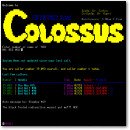[ Retro Scan of the Week ] Computer/Phone/Terminal
October 4th, 2010 by Benj Edwards All telephones should look like this. (click above for full scan)
All telephones should look like this. (click above for full scan)
It’s the Rolm Cedar — a combination PC/Telephone with 512K memory, a 9″ monitor, dual 5.25″ floppy drives, and MS-DOS 2.11. I’m not sure if this unit ever went into production, but I want one! (It also came with a keyboard, not pictured.)
Click the image above see the full text from this product’s January 1985 “What’s New” introduction in Byte Magazine.
Discussion Topic of the Week: What’s the weirdest computer you’ve ever used?






October 4th, 2010 at 3:42 pm
I had the same reaction when I saw the picture, “Holy crap! I want one.” How cool would it be to gut it and turn it into a modern PC?
October 4th, 2010 at 5:07 pm
This looks similar to a Nortel ‘Displayphone’ from the early 80s.
http://www.classiccmp.org/dunfield/disphone/index.htm
October 5th, 2010 at 7:48 pm
If a Cisco IP phone had a grandparent, that’s what it would look like.
Either that, or a fax and a pc made a baby.
October 7th, 2010 at 10:41 am
DOS could really have used a tech support hotline built into the base unit.
October 7th, 2010 at 8:04 pm
Ooh, that would have to my late grandfather’s LC.
It wasn’t an inherently weird (i.e. unique) computer, but what happened was my grandfather was in a MUG and literally collected software of all types. With at least a full row of shareware/freeware extensions (maybe two), it’s a miracle that the thing didn’t spontaneously burst into flames.
October 20th, 2010 at 12:59 pm
Yes this did go into production (and at the time it was cutting edge) and it did play games also however when IBM purchased Rolm they killed this and the Cypress (without floppy drive)product . They didnt want to compete with the IBM PC that was just released. Also at that time the company released a phone called the ETS really space age look it was the first digital phone they offered. 3 lines on 1 pair of cable. Yes what a company that was!!
October 16th, 2011 at 6:01 am
Oh my goodness! That is the sexiest piece of tech I have seen in my life! And it runs DOS 2.11?
I have to get one of these relics and put it on my writing desk! It really turns me on!
October 16th, 2011 at 6:02 am
In fact! I think I should replace my Motorola Droid X2 with one of these!
April 30th, 2012 at 2:15 pm
The Cedar was a unicorn. I never saw one. The Cypress, however, was very popular……..and a big POS. That display was an MF to repair. The rest of the phone worked OK. It had a little keyboard the slid out from under the keypad. The whole thing was really just a big dumb terminal with a phone and dialing directory. It used RS232 for the data link and required an RPD circuit card in the CBX and a Cypress load module wired into the MDF. Thank goodness I don’t have to support those anymore. We used to have some laying around for parts, but I think they are all history now.
July 19th, 2013 at 5:14 pm
I was the lead of the design team that built both Cedar and Cypress. Only about 1000 of these were sold. It was a fully self contained PC that locally ran MS-DOS 3 (if memory serves). It is funny to see it now as an interesting antique. I might still have one in my basement.
July 19th, 2013 at 7:46 pm
Was There,
Great to hear from you. If you do happen to have one in your basement, is that something you’d be willing to part with? If so, I’d love to add it to my historical collection. I’d gladly pay shipping.
Just send me an email.
October 26th, 2020 at 11:50 am
I was a ROLM tech in early 80’s and i had a Cyprus and Cedar in my office. Got rid of id in late 90’s. I do regret it now. I went thru all the ROLM technologies from CBX 7000 8000, and then 97xx when IBM bought us.
June 27th, 2021 at 2:08 am
ROLM made about 1000 Cedar units. Of the 512kB DRAM, 128 kB was used for the phone services SW, leaving 384 kB for MS-DOS and user applications. Significant effort went into making operation compatible with the original IBM PC. It could run Lotus 123 or Flight Simulator! The keyboard slid underneath. Alas, with no card slots or upgrade path, it was obsolete almost as soon as it was available. We used to accuse the mechanical engineers of owning stock in screw manufacturers, as Cedar used strain, phillips, allen, Torx, and Posi-Drive screws. Assembly was a royal pain, with lots of tumbling.
Cedar (phone and PC) and Cypress (phone and terminal) both used ROLMlink for data, voice, and telephony signalling over a single twisted pair, with 64kB/sec of data simultaneous with voice. Think of it as like a proprietary ISDN, starting in 1983. The RP120, RP240, and RP244 phones all used the same interface. The phones were highly successful, Cedar and Cypress much less so. A local grocery chain here in the NW (Fred Meyer) has Rolmphones throughout their stores, looking brand new, even in 2021, nearly 40 years after introduction.
The ETS phones were of an earlier generation, very funky-looking, but expensive, complex, and made obsolete by the RP120/RP240.
August 30th, 2021 at 5:32 pm
I have 2 Cedar units in supposed working order, but with some case damage from shipping. They require an active connection to a 9751 CBX to boot (unless there is a key sequence to bypass I don’t know about), and from the documentation I’ve been able to find neither the Cypress or Cedar have a proper BIOS but download it/bootstrap from a Personal Communication Software (PCS) “Load Module”.
The Cedar computer requires a Cedar Load Module (CDLM) and the Cypress terminal requires a Cypress Load Module (CLM)
“The CDLM stores and loads the Cedar program code to the Cedar personal computers. Software updates are installed in the CDLM without disturbing the users or physically modifying the Cedar computer”
“Cypress terminals automatically call a CLM when they are first turned on or when they lose power for more than 5 minutes. The CLM stores and transfers the program to the Cypress memory for day-to-day operation. One CLM can support up to 50 terminals”
Someday I’m going to yank the ROMs and reverse engineer the signalling, but if someone has a CDLM I can have that would speed things up greatly!